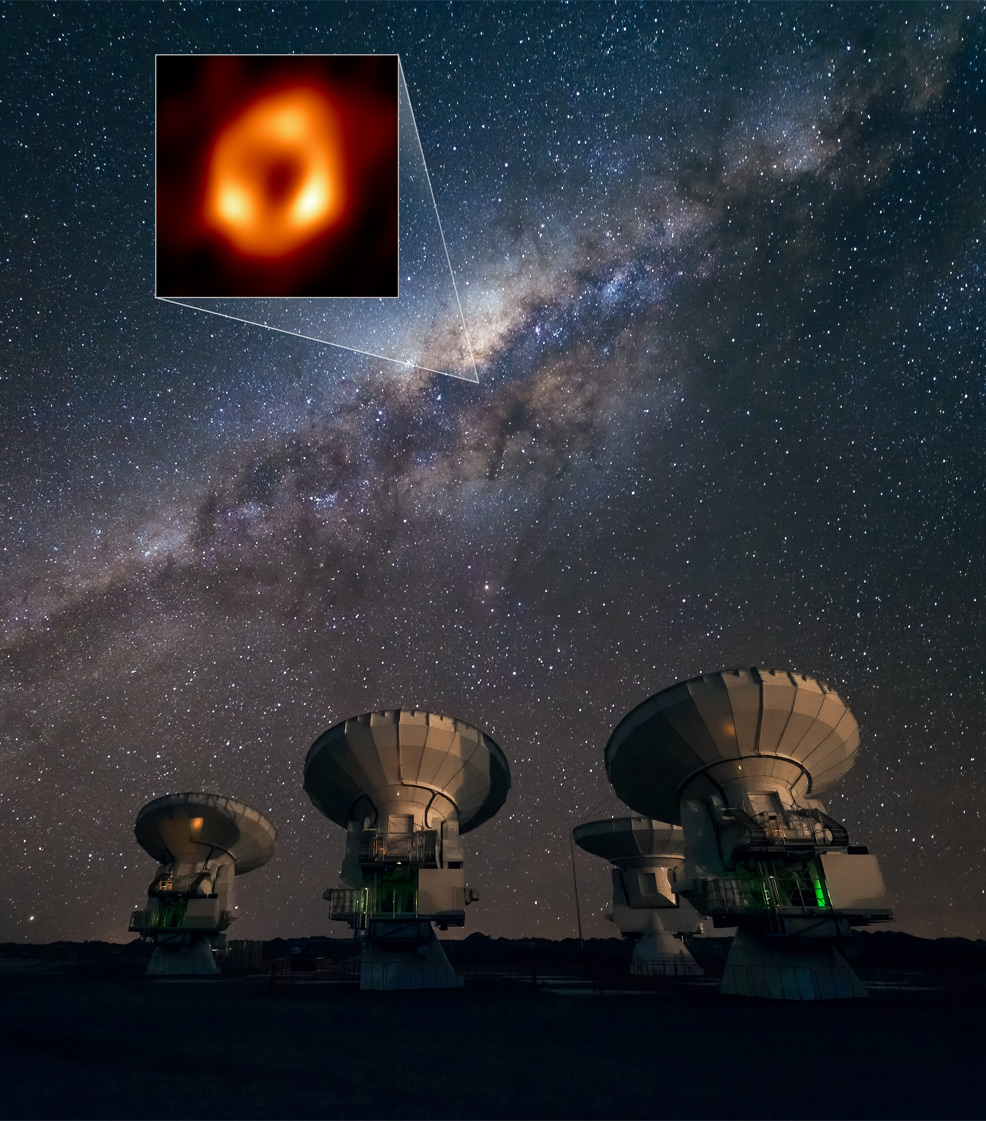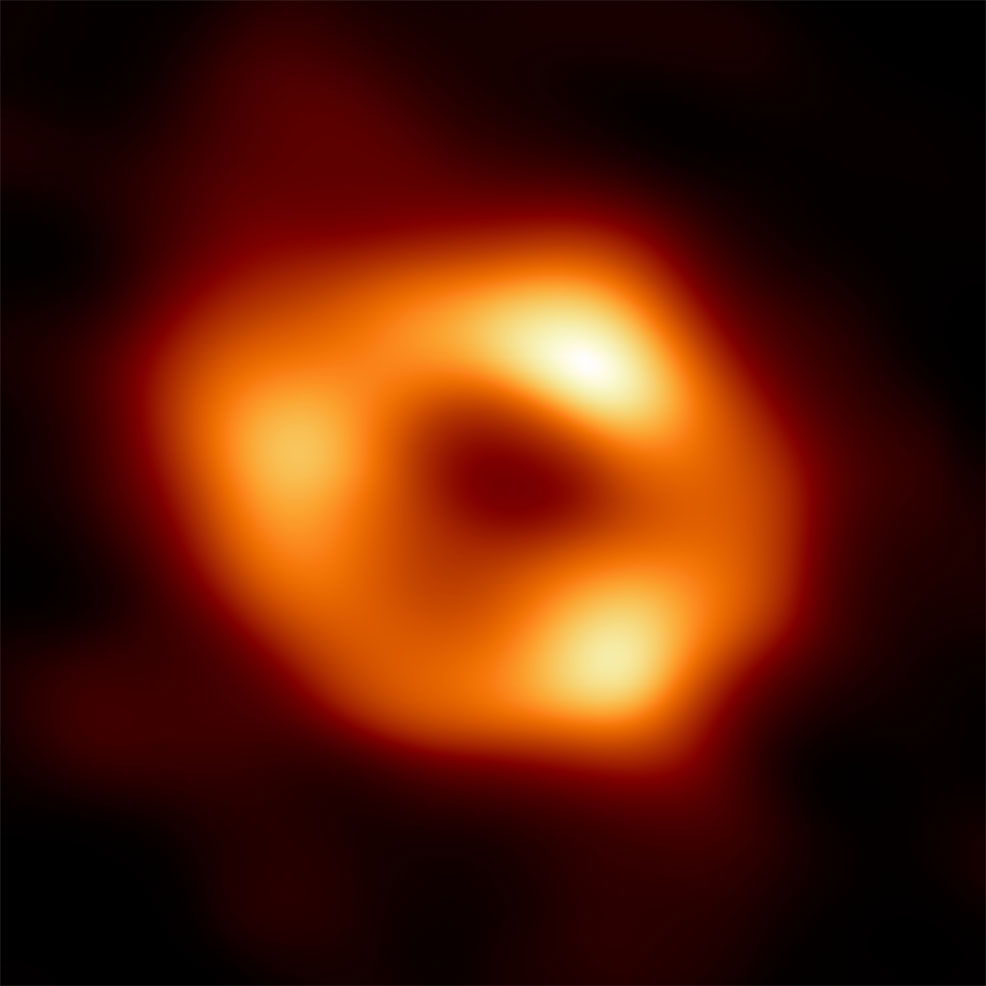
13th May 2022 First image of black hole at Milky Way's core Astronomers have revealed the first image of Sagittarius A*, the supermassive black hole at the centre of our own Milky Way galaxy.
A research team called the Event Horizon Telescope Collaboration has produced the image seen here, a major landmark in astronomy. It provides overwhelming evidence that the object at the centre of our galaxy, which has been studied for nearly a century, is indeed a supermassive black hole. This could yield valuable clues about the workings of such giants, which are thought to lurk at the centre of most galaxies. Scientists had previously observed stars orbiting around something invisible, compact, and very massive at the centre of the Milky Way (see GIF animation), suggesting that this object – known as Sagittarius A* (Sgr A*, pronounced "sadge-ay-star") – is a black hole. The new image provides the first direct visual evidence of it. Although we cannot see the black hole itself, because it is completely dark, glowing gas around it reveals a tell-tale signature: a dark central region (called a shadow) surrounded by a bright ring-like structure. The new view captures light bent by the powerful gravity of the black hole, which is four million times more massive than our Sun.
"We were stunned by how well the size of the ring agreed with predictions from Einstein's Theory of General Relativity," said EHT Project Scientist Geoffrey Bower from the Institute of Astronomy and Astrophysics, Academia Sinica, Taipei. "These unprecedented observations have greatly improved our understanding of what happens at the very centre of our galaxy, and offer new insights on how these giant black holes interact with their surroundings." The EHT team's results are published in a special issue of The Astrophysical Journal Letters. Because the black hole is 26,673 light-years from Earth, its appearance in the night sky is equivalent to us viewing a doughnut on the Moon. To image it, researchers created the powerful Event Horizon Telescope (EHT), which linked together eight existing radio observatories around the planet to form a single "Earth-sized" virtual telescope. They observed Sgr A* on multiple nights, collecting data for many hours, similar to a long exposure time on a camera. The EHT network of radio observatories includes the Atacama Large Millimeter/submillimeter Array (ALMA) and the Atacama Pathfinder EXperiment (APEX) in the Atacama Desert in Chile, the IRAM 30-metre telescope in Spain, and the NOrthern Extended Millimeter Array (NOEMA) in France. Alongside these huge telescopes (and several smaller ones) is a supercomputer to combine petabytes of data, hosted by the Max Planck Institute for Radio Astronomy, Germany. This achievement follows the EHT collaboration's image of M87*, in the more distant Messier 87 galaxy, which became the first ever image of a black hole, released in April 2019. The two black holes look remarkably similar, even though our galaxy's black hole is more than a thousand times smaller and less massive than M87*.
"We have two completely different types of galaxies and two very different black hole masses, but close to the edge of these black holes they look amazingly similar," said Sera Markoff, Co-Chair of the EHT Science Council and professor of theoretical astrophysics at the University of Amsterdam, Netherlands. "This tells us that General Relativity governs these objects up close, and any differences we see further away must be due to differences in the material that surrounds the black holes." This achievement proved to be considerably more difficult than for M87*, even though Sgr A* is much closer to us, as explained by EHT scientist Chi-kwan Chan from the University of Arizona, USA: "The gas in the vicinity of the black holes moves at the same speed – nearly as fast as light – around both Sgr A* and M87*. But where gas takes days to weeks to orbit the larger M87*, in the much smaller Sgr A* it completes an orbit in mere minutes. This means the brightness and pattern of the gas around Sgr A* were changing rapidly as the EHT Collaboration was observing it, a bit like trying to take a clear picture of a puppy quickly chasing its tail." More than 300 researchers from 80 institutes around the world make up the EHT Collaboration. In addition to developing complex tools to overcome the challenges of imaging Sgr A*, the team worked extensively with supercomputers to combine and analyse their data, all while compiling an unprecedented library of simulated black holes to compare with observations. They have now begun to use the new data to test theories and models of how gas behaves around supermassive black holes – a process not yet fully understood, but thought to play a key role in shaping the formation and evolution of galaxies. "Now we can study the differences between these two supermassive black holes to gain valuable new clues about how this important process works," explained EHT scientist Keiichi Asada from the Institute of Astronomy and Astrophysics, Academia Sinica, Taipei. "We have images for two black holes, one at the large end and one at the small end of supermassive black holes in the Universe – so we can go a lot further in testing how gravity behaves in these extreme environments than ever before." Progress on the EHT continues: more telescopes are being added to its network. This ongoing expansion combined with significant technological upgrades will allow scientists to share even more impressive images, as well as movies of black holes in the near future.
Comments »
If you enjoyed this article, please consider sharing it:
|








